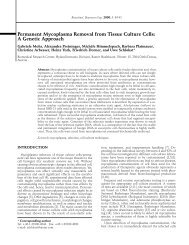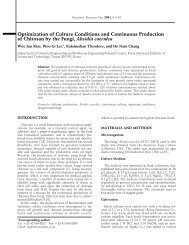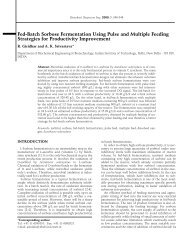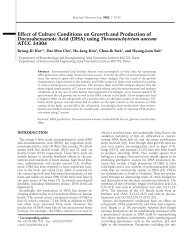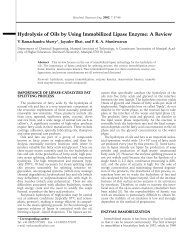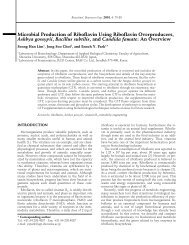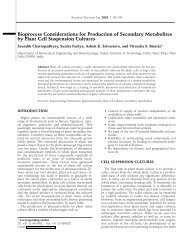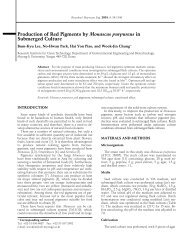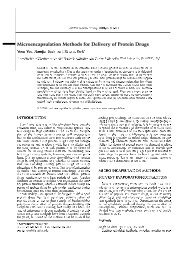Microencapsulation Methods for Delivery of Protein Drugs
Microencapsulation Methods for Delivery of Protein Drugs
Microencapsulation Methods for Delivery of Protein Drugs
You also want an ePaper? Increase the reach of your titles
YUMPU automatically turns print PDFs into web optimized ePapers that Google loves.
Biotechnol. Bioprocess Eng. 2001, Vol. 6, No. 4 219<br />
d<br />
s<br />
e<br />
a<br />
R<br />
e<br />
le<br />
e<br />
%<br />
u<br />
la<br />
tiv<br />
C<br />
u<br />
m<br />
100<br />
75<br />
50<br />
25<br />
0<br />
0 2 4 6 8<br />
Time (days)<br />
100/0<br />
80/20<br />
0/100<br />
7. Release <strong>of</strong> GM-CSF from microspheres prepared from<br />
Fig.<br />
PLA (MW 6,100) (0/100), 80%/20% mixture <strong>of</strong> PLGA<br />
100%<br />
40,400)/PLA (80/20), and 100% PLGA (100/0). From<br />
(MW<br />
[41].<br />
reference<br />
microspheres, the in vivo peptide release reached<br />
timized<br />
peak level on day 15 and the effect lasted <strong>for</strong> 1<br />
the<br />
month.<br />
colony-stimulating factor<br />
Granulocyte-macrophage<br />
was encapsulated in different blends <strong>of</strong><br />
(GM-CSF)<br />
and low molecular weight PLA by the non-<br />
PLGA<br />
addition method, and the prepared microsolvent<br />
were characterized both in vitro and in vivo [41].<br />
spheres<br />
microspheres with high encapsulation efficiency<br />
The<br />
obtained within a size range between 20 µm and<br />
were<br />
µm. The in vitro release kinetics was dependent on<br />
80<br />
ratio <strong>of</strong> blended polymers. Steady release <strong>of</strong> GM-<br />
the<br />
could be achieved over a period <strong>of</strong> one week with-<br />
CSF<br />
significant burst effect using blend <strong>of</strong> low molecular<br />
out<br />
PLA and high molecular weight PLGA (Fig. 7).<br />
weight<br />
released from the microspheres was found to<br />
GM-CSF<br />
physically intact and biologically active both in vitro<br />
be<br />
in vivo. and<br />
avoid the aggregation <strong>of</strong> microparticles <strong>of</strong>ten en-<br />
To<br />
in non-solvent addition, a modified method<br />
countered<br />
developed [42]. Instead <strong>of</strong> adding non-solvent to a<br />
was<br />
mixture, the polymer solution was added<br />
polymer-drug<br />
an emulsion <strong>of</strong> aqueous ovalbumin in the non-<br />
to<br />
silicon oil. The obtained microspheres appeared<br />
solvent<br />
and remained individual, and displayed a small<br />
smooth<br />
release <strong>of</strong> entrapped ovalbumin over the first 12<br />
initial<br />
with the subsequent release pr<strong>of</strong>ile close to a<br />
hours,<br />
order kinetics <strong>for</strong> a month. Another modification<br />
zero<br />
the non-solvent addition method was introduced to<br />
<strong>of</strong><br />
protein entities from denaturation at the or-<br />
protect<br />
interface or unfolding and/or aggregaganic/aqueous<br />
within hydrophobic polymer matrix [40,43,44].<br />
tion<br />
hydrophilic nanoparticles were pre-<br />
Drug-containing<br />
prior to encapsulation with hydrophobic polymer.<br />
pared<br />
[40], agarose [43], and poly(vinyl alcohol) (PVA)<br />
Gelatin<br />
were used as nanoparticle matrices <strong>for</strong> BSA or insu-<br />
[44]<br />
Nanoparticles were suspended in PLGA-dichlorolin.<br />
solution. Microparticles embedded with nanomethane<br />
were made by phase separation method using<br />
particles<br />
oil as the first non-solvent and heptane as the<br />
silicone<br />
non-solvent. The average diameter <strong>of</strong> the hydro-<br />
second<br />
nanoparticle-hydrophobic microsphere composi-<br />
philic<br />
was 150-180 µm. The protein release from the mi-<br />
tes<br />
was prolonged to nearly two months, withcrospheres<br />
degradation nor aggregation <strong>of</strong> the protein as<br />
out<br />
by size exclusion chromatograms [44].<br />
shown<br />
separation by salt addition was adopted in<br />
Phase<br />
<strong>of</strong> ionotropic hydrogel in an attempt to<br />
preparation<br />
the size distribution <strong>of</strong> microspheres [45]. Prior<br />
control<br />
cross-linking with calcium ions, salts <strong>of</strong> monovalent<br />
to<br />
(e.g., sodium chloride) were added to aqueous solu-<br />
ions<br />
<strong>of</strong> poly [di(carboxylatophenoxy) phosphazene]<br />
tion<br />
to <strong>for</strong>m coacervate microdroplets with a size in<br />
(PCPP)<br />
range 1-10 µm. Upon addition <strong>of</strong> calcium chloride,<br />
the<br />
microdroplets were stabilized via cross-linking be-<br />
the<br />
PCPP and calcium salts without changing the<br />
tween<br />
and shape. The microsphere size increased linearly<br />
size<br />
the sodium chloride concentration, incubation<br />
with<br />
and polymer concentration. This method avoided<br />
time,<br />
use <strong>of</strong> organic solvents, heat, and complicated<br />
the<br />
equipment. Gelatin/Chondroitin 6-sulfate<br />
manufacturing<br />
microspheres were prepared to encapsulate pro-<br />
(CS6)<br />
using complex coacervation <strong>for</strong> the joint therapy<br />
teins<br />
Gelatin (a polycation) and CS6 (a polyanion) solu-<br />
[46].<br />
containing model proteins were mixed and vortions<br />
at 37°C, pH 5.5 to <strong>for</strong>m coacervates. The resulting<br />
texed<br />
microspheres were crosslinked with glu-<br />
coacervate<br />
It was claimed that proteins could be entaraldehyde.<br />
with high encapsulation efficiency, retaining<br />
capsulated<br />
bioactivity. The release <strong>of</strong> protein depended on the<br />
high<br />
<strong>of</strong> human matrix metalloprotease (MMP), since<br />
level<br />
coacervate was degraded by its gelatinase<br />
gelatin/CS6<br />
The MMP concentration is one <strong>of</strong> the factors<br />
activity.<br />
<strong>for</strong> the joint pain, and thus the MMP-<br />
responsible<br />
release property is <strong>of</strong> distinctive advantage<br />
responsive<br />
the delivery <strong>of</strong> MMP inhibitors or the receptors <strong>for</strong><br />
<strong>for</strong><br />
stimulating the synthesis <strong>of</strong> MMP to diseased<br />
cytokines<br />
Gelatin/CS6 showed no significant cytotoxic<br />
joints.<br />
effect in vitro.<br />
Advantages<br />
non-solvent addition method is preferred in en-<br />
The<br />
<strong>of</strong> water-soluble drugs, such as proteins,<br />
capsulation<br />
and vaccines, since drug-polymer mixtures are<br />
peptides,<br />
exposed to the continuous aqueous phase. This<br />
not<br />
the loss <strong>of</strong> water-soluble drugs to the water<br />
minimizes<br />
and results in the high encapsulation efficiency.<br />
phase<br />
advantage <strong>of</strong> the phase separation method is<br />
Another<br />
it enables efficient control <strong>of</strong> the particle size with<br />
that<br />
narrower size distribution by simply varying the<br />
a<br />
variables, such as concentration <strong>of</strong> added<br />
component<br />
[45] or the viscosity and amount <strong>of</strong> the non-<br />
salts<br />
and/or molecular weight <strong>of</strong> polymer used [47].<br />
solvent





